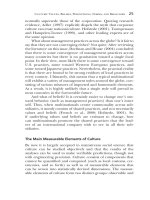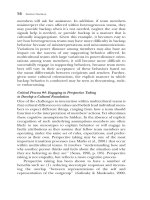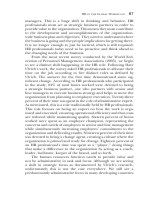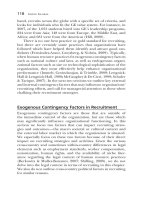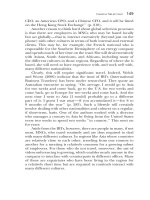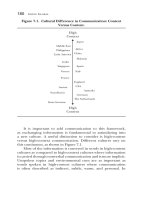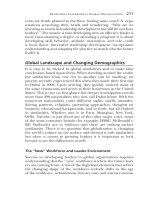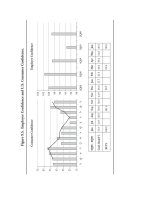Practical Applications and Recommendations for HR and OD Professionals in the Global Workplace J-B SIOP Professional Practice Series_10 potx
Bạn đang xem bản rút gọn của tài liệu. Xem và tải ngay bản đầy đủ của tài liệu tại đây (452.45 KB, 13 trang )
7.–Michael Beer and Nitin Nohria, “Cracking the Code of Change,”
Harvard Business Review 78, no. 3 (May–June 2000): 137.
Chapter 5
1.–Eric Hoffer,The Ordeal of Change (Cutchogue,NY:Buccaneer Books,
1976), 3.
2.–See the Myers-Briggs Type Indicator
®
, Consulting Psychologists
Press, Inc.
3.–See W. Christopher Musselwhite and Robyn Ingram, Change Style
Indicator (Greensboro, NC:The Discovery Learning Press, 1999).
4.–Ibid., 4.
5.–Paul R. Lawrence,“How to Deal With Resistance to Change,” Har-
vard Business Review XLVII ( January–February 1969): 4–12, 166–176.
6.–Robert Kegan and Lisa Laskow Lahey, “The Real Reason People
Wo n’t Change,” Harvard Business Review 79, no. 10 (November 2001):
84–92.
7.–Everett M. Rogers, Diffusion of Innovation, 3rd ed. (New York: The
Free Press, 1983) 315–316.
Chapter 6
1.–Harry Woodward and Steve Bucholz, Aftershock (New York: John
Wiley & Sons, Inc., 1987).
2.–Adapted from Todd D. Jick, “Note on the Recipients of Change,”
Note 9-491-039 (Boston: Harvard Business School, 1990, revised 1996).
3.–Ken Hultmans, The Path of Least Resistance (Austin, TX: Learning
Concepts, 1979).
Chapter 7
1.–Robert Schaffer, “Rapid-Cycle Successes versus the Titanics,” in
Breaking the Code of Change, eds. Michael Beer and Nitin Nohria (Boston,
MA: Harvard Business School Press, 2000), 362.
2.–James R. Bright,“Evaluating Signals of Technological Change,” Har-
vard Business Review XLVIII ( January–February 1970): 64.
3.–James C. Collins and Jerry I. Porras, “Building Your Company’s Vi-
sion,” Harvard Business Review 74, no. 5 (September–October 1996): 66.
Notes 127
125-128 HBE-MCT NOTES 3rd 10/15/02 9:59 AM Page 127
125-128 HBE-MCT NOTES 3rd 10/15/02 9:59 AM Page 128
This Page Intentionally Left Blank
For Further Reading
Communication Issues
Larkin, T. J., and Sandar Larkin. “Reaching and Changing Frontline Em-
ployees,” Harvard Business Review 74, no. 3 (May–June 1996): 95–104.
Planning a major change in your organization? If so, chances are you
have arranged a huge rally, rousing speeches, videos, and special editions
of the company paper. Stop. This sort of communication does not
work. If you want people to change the way they do their jobs, you
must change the way you communicate with them. Drawing on their
own research and the research of other communication experts from
the past two decades, the authors argue that senior managers—and
most communication consultants—have refused to hear what frontline
workers have been trying to tell them: When you need to communi-
cate a major change, spend most of your time, money, and effort on
frontline supervisors.
General Issues
Beer, Michael, Russell A. Eisenstat, and Bert Spector. The Critical Path to
Corporate Renewal. Boston, MA: Harvard Business School Press, 1990.
Based on a study of six large corporations that tried to transform them-
selves, this book explains why some enjoyed greater success than others,
and offers a practical approach that managers can adopt. Also worth read-
ing from these same authors is,“Why Change Programs Don’t Produce
Change,” Harvard Business Review 68,no. 6 (November–December 1990):
7–12.
Brenneman, Greg. “Right Away and All at Once: How We Saved Conti-
nental,” Harvard Business Review 76, no. 5 (September–October 1998):
162–179. Not many corporatewide change programs succeed.This one
did, and it makes for interesting reading. In 1994, Continental Airlines
was headed for a crash landing—quickly running out of customers and
129
129-132 HBE-MCT BIBLIO 3rd 10/15/02 10:00 AM Page 129
cash. A simple strategy, executed fast, right away, and all at once, says
Greg Brenneman, president and COO of the company, pulled it out of
its death spiral. He describes the five lessons he learned during this dra-
matic turnaround.With Gordon Bethune, Continental’s chairman and
CEO, Brenneman devised the Go Forward Plan, a straightforward strat-
egy focused on four key elements: understanding the market, increasing
revenues, improving the product, and transforming the corporate cul-
ture. Brenneman admits that the plan wasn’t complicated—it was pure
common sense.The tough part was getting it done.“Do it now!”became
the rallying cry of the movement, and the power of momentum carried
Continental to success.
Kotter, John P. Leading Change. Boston: Harvard Business School Press,
1996. Emphasizing the need for leadership to make change happen—
and stick—this book identifies an eight-step process that every organi-
zation must go through in order to achieve change goals. It shows
where and how people often derail the process, and how those errors
can be avoided.
Realizing Change (part of The Interactive Manager Series of multimedia
learning tools on CD-ROM). Boston: Harvard Business School Pub-
lishing, 1999. Realizing Change, based on John Kotter’s book, Leading
Change, is designed to help managers acquire the understanding and
skills needed to lead and manage organizational change. Unlike the
book, the CD version organizes the change agenda into three sequential
phases: set up, roll out, and follow through.The interactive nature of the
program allows users to drill down into various levels of detail on each
phase, including case studies and other available readings.
Schaffer, Robert H., and Harvey A. Thomson. “Successful Change Pro-
grams Begin with Results,” Harvard Business Review 70, no. 1 ( January–
February 1992): 80–89. If you think that big change programs with
grandiose visions are bunk, you’ll like this article. Most corporate im-
provement efforts have negligible results, according to these authors, be-
cause they focus on activities, not results, and there is no explicit
connection between action and outcome.“Results-driven” approaches
offer greater potential for improvement because they focus on achieving
specific, measurable goals. By committing to incremental change, man-
agers not only can see results faster but also determine more quickly
what is working and what isn’t.
Leadership Issues
Conner, Daryl R. Managing at the Speed of Change: How Resilient Managers
Succeed and Prosper Where Others Fail. New York: Villard Books, 1993.
The author notes eight patterns and many principles that can be used
130 For Further Reading
129-132 HBE-MCT BIBLIO 3rd 10/15/02 10:00 AM Page 130
successfully by those responsible for change in their organizations.The
patterns involve the nature of change, the process of change, the roles
played during change, resistance to change, commitment to change,
how change affects culture, synergism, and the nature of resilience.
Connor states that the degree to which people demonstrate resilience is
the key factor in managing change successfully.
Luecke, Richard. Scuttle Your Ships Before Advancing:And Other Lessons from
History on Leadership and Change for Today’s Managers. New York: Oxford
University Press, 1994.This collection of historical episodes dramatizes
the plight of leaders faced with uncertainty and change.The episodes
range from the Aztec world at the time of Cortez’s appearance,to the bat-
tle of Agincourt,to revolutionary Boston. Among other things,the book
contains an interesting chapter on the power of ideas to drive change.
People Issues
Jeffreys, J. Shep. Coping with Workplace Change: Dealing with Loss and Grief.
Menlo Park, CA: Crisp Publications, 1995.This short book was written
for survivors of layoffs and other organizational changes, but it holds
value for anyone in an organization undergoing major change.
Musselwhite, W. Christopher, and Robyn Ingram. Change Style Indicator.
Greensboro, NC: The Discovery Learning Press, 1999. This “Study
Guide” is an assessment instrument designed to measure an individual’s
preferred style in approaching change and in addressing situations in-
volving change.Knowing in advance how people respond to change can
help you enlist their collaboration.This and Discovery Learning’s other
training and consulting products are available through its Web site:
<>.
Pritchett, Price. New Work Habits for a Radically Changing World. Dallas,TX:
Pritchett & Associates, 1994. This book offers guidelines for job man-
agement during radical change.The author’s viewpoint is that change in
organizations is only a response to change in the world, and therefore,
employees must take personal responsibility for their own careers.
Strebel, Paul. “Why Do Employees Resist Change?” Harvard Business Re-
view 74, no. 3 (May–June 1996): 86–92.The problem with many change
programs isn’t the programs themselves. It’s that too few people, at every
level, really support the initiative with their hearts and minds.This inter-
esting article explains that organizations have personal compacts with
their employees. Change efforts fail when those compacts are ignored.
For Further Reading 131
129-132 HBE-MCT BIBLIO 3rd 10/15/02 10:00 AM Page 131
129-132 HBE-MCT BIBLIO 3rd 10/15/02 10:00 AM Page 132
This Page Intentionally Left Blank
Index
133
agents, change. See change agents
Brenneman, Greg, 62–63
Champion International, 12 –13
change
continuous (see continuous
change)
economic approach (see Theory E)
implementing (see implementing
change)
organizational capabilities
approach (see Theory O)
process of (see seven steps to
change)
readiness for (see change-readiness)
summary, 15
types of, 8–9
change agents
identifying, 78, 79
insider-outsider, 78, 79–80
roles of, 77
change-readiness
achieving, 25–29
approaches for accomplishing
change, 21–22
complacency signs, 21–22, 23t
leadership and, 18–19
motivation to change, 19–21
nonhierarchical organizations
and, 24–25
rewards as motivation, 22–24
summary, 29–30
conservers and change, 72, 73
consultants and implementing
change
background to use, 62, 64
choosing, 120–121, 123
fees, 121–122
success of partnership, 122
types and approaches used,
64–65
variations in roles, 65–67
when to hire, 119–120
Continental Airlines, 62–63
continuous change
accomplishing, 106, 107–109,
110
advantages of, 104
discontinuous versus, 102–104
information management
evaluation, 118t
peoples’ responses to, 104–106
summary, 110–111
C performers, 19
Deming,W. Edwards, 19–20
133-136 HBE-MCT INDEX 3rd 10/16/02 2:31 PM Page 133
economic approach to change.
See Theory E
Eddystone Generating Station,
40–42
empowering people, 26–27, 28
Endurance, 98–99
Ford Motor Company, 20–21
General Electric, 13–15, 66
General Motors, 21, 29
Herman Miller Company, 43
HR personnel, 46–47
human factors regarding change.
See social and human factors;
stress due to workplace change
implementing change
common problems, 52–53
communication’s importance,
62–63
communication tips, 60–62
consistency need, 56–57
consultants and (see consultants
and implementing change)
enabling structures development,
57–58
leadership self-evaluation,
114–115t
milestone celebration, 58–59
obstacles identification, 117t
online tools Web site, 113
plan creation, 54–56
stress levels management
evaluation, 116t
summary, 67–68
team member selection, 53–54, 55
leadership
change-readiness and, 18–19
in a change situation, example
of, 98–99
characteristics of change leaders,
38–39
relationship to management, 46,
47f
self-evaluation, 114–115t
managers’ role in change
dealing with change, 88–89
helping employees, 94–95, 96
role in steps to change, 46–47
Nordstrom, 110
organizational capabilities approach
to change. See Theory O
originators and change, 72, 73–74
passive resisters and change, 76
pragmatists and change, 72, 73
resisters
social factors regarding change
and, 74–76
stress due to change and, 96–97
rewards
change implementation and,
58, 59
change-readiness and, 22–24
Scott Paper, 12–13
seven steps to change
focus on results, 39–42, 117t
134 Index
133-136 HBE-MCT INDEX 3rd 10/16/02 2:31 PM Page 134
institutionalizing of success, 44
leaders’ and managers’ roles,
46–47
leadership and, 38–39
mistakes to avoid, 47–48
motivating change, 37
problem identification, 33–35
self-diagnosis of approach, 45t
shared vision development,
36–38
solution development, 35–36
start at periphery, 43–44
strategy monitoring and adjust-
ment, 45
summary, 49–50
Shackleton, Sir Ernest, 98–99
“simple, quick, affordable” (SQA),
43
social and human factors
change agents, 77, 78, 79–80
rank and file reactions, 70–74
resisters, 74–76
stress caused by change (see stress
due to workplace change)
summary, 81
statistical process control (SPC),
19–21
stress due to workplace change
individual’s role in dealing with
change, 89–92
leadership example, 98–99
managers’ role in dealing with
change, 88–89
managers’ role in helping employ-
ees, 92–96
resisters and, 96–97
sense of loss and anxiety, 85–86
stages of reactions, 86–88
stress levels management evalua-
tion, 116t
summary, 99–100
Theory E
described, 10, 65–66
theories comparison, 11–15, 15t
Theory O
described, 11, 66
theories comparison, 11–15, 15t
Walt Disney, 109
Web site for online change tools,
113
Xerox, 37
Index 135
133-136 HBE-MCT INDEX 3rd 10/16/02 2:31 PM Page 135
133-136 HBE-MCT INDEX 3rd 10/16/02 2:31 PM Page 136
This Page Intentionally Left Blank
About the Subject Adviser
MIKE BEER is Cahners-Rabb Professor of Business Administration,
Emeritus, at the Harvard Business School, where he still teaches in
the areas of organizational effectiveness, human resource manage-
ment, and organizational change. Prior to joining the Harvard fac-
ulty, he was Director of Organization Research and Development
at Corning, Inc., where he was responsible for stimulating a number
of innovations in management. He has authored or coauthored sev-
eral books and articles. The Critical Path to Corporate Renewal (Har-
vard Business School Press, 1990), which deals with the problems of
large-scale corporate change, won the Johnson, Smith, and Knisley
Award for the best book in executive leadership in 1991 and was a fi-
nalist for the Academy of Management Terry Book Award that year.
His most recent book, edited with Nitin Nohria, is Breaking the Code
of Change (Harvard Business School Press, 2000). In the last several
years, Professor Beer has developed and researched a process by which
top teams can assess and develop their organization’s capability to
implement their strategy.He has served on the editorial board of sev-
eral journals and the board of governors of the Academy of Manage-
ment, is Chairman of the Center for Organizational Fitness, and has
consulted with many Fortune 500 companies.
137
137-140 HBE-MCT ASA-ATW 3rd 10/16/02 2:52 PM Page 137
About the Writer
RICHARD LUECKE is the writer of several books in the Harvard
Business Essentials series. Based in Salem, Massachusetts, Mr. Luecke
has authored or developed over thirty books and dozens of articles
on a wide range of business subjects. He has an M.B.A. from the
University of St.Thomas.
138
137-140 HBE-MCT ASA-ATW 3rd 10/16/02 2:52 PM Page 138
Need smart, actionable
management advice?
Look no further than your desktop.
Harvard ManageMentor®, a popular online performance support tool
from Harvard Business School Publishing, brings how-to guidance and
advice to your desktop, ready when you need it, on a host of issues critical
to your work.
Heading up a new team? Resolving a conflict between employees? Preparing
a make-or-break presentation for a client? Setting next year’s budget? Har-
vard ManageMentor®Online delivers answers and advice on 33 topics
right to your desktop
—
any time, all the time, just in time.
•
Downloadable modules on 28 essential topics allow you to build a per-
sonal management resource center right on your computer
•
Practical tips, tools, checklists, and resources help you enhance produc-
tivity and performance now
•
Advice from seasoned experts in finance, communications, teamwork,
coaching and more
—
accessible with a few mouse clicks
•
Multiple language versions available
Go to today to try out
two complimentary Harvard ManageMentor
®
(HMM) Online topics.
Individual topic modules are available for $14.95 each, or you can order the com-
plete HMM Online program (33 topics in all) for $129. Corporate site licenses are also
available. For more information or to order, call 800.795.5200 (outside the U.S. and
Canada: 617.783.7888) or visit www.harvardmanagementor.com/demo.
137-140 HBE-MCT ASA-ATW 3rd 10/16/02 2:52 PM Page 139


